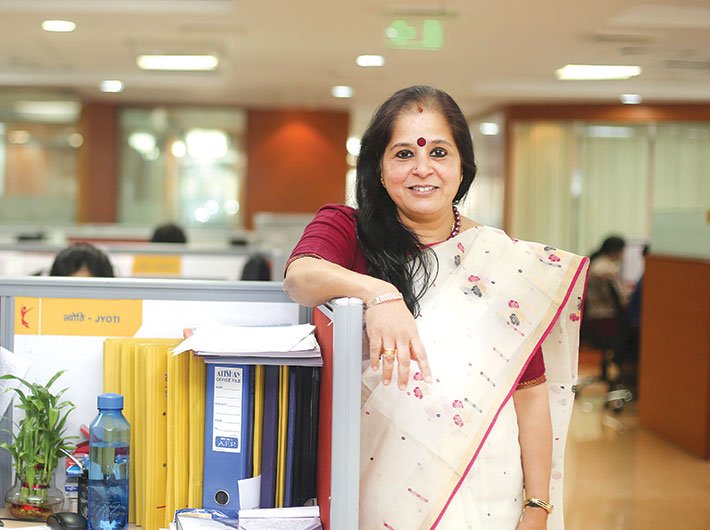Usha Ananthasubramanian is the first head of India’s first bank meant for women. Set up in November 2013, Bharatiya Mahila Bank, is the youngest and smallest of the public sector banks, but is attracting attention thanks to its unique mandate. Ananthasubramanian spoke with Sweta Ranjan about the crucial aspect of gender in financial inclusion. Edited excerpts:
Within six months of the launch of PMJDY, around 11 crore accounts were opened, 55 percent of which were of women. How many accounts have been opened in your bank?
We are a very small bank compared to many other players. We were hardly seven-eight months old when the scheme was rolled out. Over a period of time we have added 18 branches, but at that time we had only 23 active players scattered from Sikkim to Thiruvananthapuram, Guwahati to Ahmedabad. We had been able to open 58,000 accounts by February. It was more than 2,000 accounts per branch.
What are your views on the scheme as applied to women?
It is a huge societal transformation, because women who have been even shy to come out are able to come to a bank and ask for an account. In Indian society the man may earn and be the breadearner but ultimately it’s the woman who runs the household. It is the woman who aspires for improving the standard of living for the family. It is the woman who plans to send children to a better school, have better food, better clothing.
I would say it is a blessing in disguise for the woman. All these years her money was kept in a masala box. She was hiding it from the man who would otherwise take it away. Only thing she did not know was that her money could multiply. Her '100 can become '105 or '1,000. She never knew that a bank could help.
How do you foresee the growth of your bank?
It is a segment-specific bank, but it is a commercial bank. To be precise, we are 17 months old. This is a very small period to say what it can be after 10 or 15 years. But, yes, we see a progressive path ahead. Again, you must appreciate that the network is very lean today and we cannot have 4,000 branches overnight. If a PSB (public sector bank) has 4,000 branches, it has happened over a period of 100 years. We have set up 60 branches so far.
What roadblocks do you face in terms of infrastructure, technology and manpower?
Technology is not a problem. Within exactly one year we have launched internet banking which is a very difficult technology product. We are very shortly going to unleash mobile banking. But everything cannot happen overnight. The day we launched internet banking there was hardly anyone to use it – today all the officers are using it, and slowly people are beginning to appreciate it.
Manpower is a problem because initially we had drawn people on deputation and now they would like to go back. We have to recruit as we open branches. Other banks can have the luxury of hiring 2,000 officers, keeping them scattered and drawing them in as they want. Staff is a big constraint for us.
By when do you think you’ll be able to reach women in remote areas?
Nobody has reached the remotest areas except the post office. Only 35,000-40,000 rural branches exist in 6,00,000 villages. We are looking for unbanked rural areas. We are going to Vadodara to see some unbanked villages. We are also looking at [areas around] Cuttack, Ahmedabad, and in Karnataka.
Is digital illiteracy a hindrance when it comes to rural women?
Rural women are very smart. When we got our accounts opened we had to fill the typical forms, we had to carry our passbooks along to the branch, they would verify the balance and only then we could operate. But today the great change is that even women who are illiterate are starting off with a debit card. The power of technology has reached these people who have never seen a smart card.
That is when financial literacy becomes very important. There is a lack of digital literacy among not only rural women but also urban women. Many women are scared of entering an ATM cabin.
Do you feel rural women would not be comfortable using ATMs?
I believe they would certainly be comfortable because there is fear only the first time. Some ATMs have a swipe system and some have dip. In the dip system the card dips in, and it comes out only after the transaction. Some people get nervous and think the card has been ‘swallowed’. There is a psychological fear but once you operate it, you know it comes out, so you don’t fear the next time.
You give them the experience or put the responsibility on the business correspondent who has a micro ATM or handheld device. These women should be very happy. First, walking for 10 km or depending on the local man is all wiped out. These people don’t have the limitation on the use. We want them to transact more. The best thing is that they are being recognised as those who can trigger economic growth.
The amount collected under PMJDY is massive. Everybody thought every account will be zero balance, but today it is not so. There are people who have opened this with '1,000. Almost '8,000 crore has been deposited. We have collected '4,300 crore out of 50,000 accounts.
How do you see micro-financing being done through these accounts?
The first task of bringing them to a formal channel is done. Every woman is good at doing something: she can weave baskets or do something like that. They are already skilled or they can be skilled. They need very small loans. Financial literacy continues to the extent of giving them loan and inculcating in them the habit of repaying the loan. Women undergo peer pressure: if you pay I have to pay. They are always in a group. They are very aspiration-driven. If a woman in a village has a sewing machine, she thinks, ‘let me buy one more, I can engage one more person.’
Have banks been able to maintain pace with the number of accounts?
Accounts have been opened. The next stage is to get them funded. Today we have given you an identity that you are an account holder in Bank A or B. The next job is to help you fund these accounts and then start transacting. Then you get into the habit or cycle of transacting. The interest is created by putting more money and seeing it grow. Then you reach a level where you gain the confidence that ‘I am able to save, let me look at taking a loan.’ Then the cycle elongates.
What are your schemes for women?
When we started Mahila Bank, we worked on some products which could leverage the strength of women. We have the regular car and education loans, but we wanted something especially for women. How do you tap their potential?
Indian women are very good in preparing food. I won’t say kitchen is their destination, but there is an intrinsic interest in cooking for the family. Our Annapurna scheme encourages women to work from home and supply food to offices, small parties, and then the client base will expand. We support them with a loan.
Our Shringar loan is for setting up a beauty salon. We have tie-ups with big brands in beauty salons. They train women and give franchisee rights. We fund these women. We are looking at this segment, as Indian women do not have property in their name to give as collateral.
There are schemes available under Credit Guarantee Fund Trust for Micro and Small Enterprises. Under this scheme they don’t have to give a collateral; they just have to pay a small premium. It is applicable to men also. In Noida a woman started a beauty parlour six months ago and now she wants to start six more. Then we have a project called Parvarish, meant for setting up daycare centres. Kindergartens and playschools too are exclusive areas for women. We see this as a two-way benefit because it is helpful to a working mother. And she can generate income for herself.
Komal Kali is a product for girl children. In our society we talk of the equality of the son and the daughter but when it comes to higher studies the boy goes to an IIT and the girl to the nearest college. If parents can save for the girl child on long-term basis, she will have a corpus when she is 18. Komal Kali can be started with any amount.
sweta@governancenow.com
( The interview appears in the June 1-15, 2015 issue)

